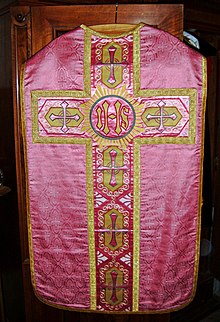Laetare Sunday
This Sunday gets its name from the first few words (incipit) of the traditional Latin entrance verse (Introit) for the Mass of the day.The full Introit reads:[2][3] Laetare Jerusalem et conventum facite omnes qui diligitis eam; gaudete cum laetitia, qui in tristitia fuistis, ut exsultetis et satiemini ab uberibus consolationis vestrae.[6] The station church at Rome for this day was Santa Croce in Gerusalemme, one of the seven chief basilicas; the Golden Rose, sent by Popes to Catholic sovereigns, used to be blessed at this time and for this reason the day was sometimes called Dominica de Rosa.[10] The term "rose" is used to describe this lighter shade of the color violet in the Roman Rite.The earliest occurrence of Laetare Sunday in the twenty-first century was on 2 March 2008,[14] and the latest will be on 4 April 2038.



Western ChristianityChurch servicesfeastspartiesEaster SundayincipitGregorian chantintroitchasubleChurch LatinClassical LatinEnglishWestern Christianliturgical calendarIsaiah 66Roman CatholicLutheranAnglicanI was gladMothering SundayRefreshment Sundaygolden rosevestmentsmiracle of the loaves and fishescommon lectionariesGospelOld Catholicstation churchSanta Croce in GerusalemmebasilicasBishop of WillesdenNorth Actonsacramentbaptismhigh altarRoman RiteEastermother churchUniversity of Notre DameLaetare Medalmoveable feastbased on the cycles of the moonGaudete SundayChurch Publishingliturgical colourCommon WorshipCongregation for Divine Worship and the Discipline of the SacramentsEaster cycleFifth Sunday of LentLiturgical yearCatholic ChurchOrdinary FormLatin Church1969 CalendarAdventImmaculate ConceptionDecember 17 to 23Christmas SeasonChristmasChristmas EveMidnight MassHoly FamilyMary, Mother of GodEpiphanyBaptism of the LordOrdinary TimePresentation of the LordAsh WednesdaySaint JosephAnnunciationPalm SundayHoly WeekPaschal TriduumHoly ThursdayChrism MassMass of the Lord's SupperGood FridayHoly SaturdayEaster VigilEaster SeasonOctaveDivine Mercy SundayAscensionPentecostTrinity SundayCorpus ChristiSacred HeartVisitationNativity of John the BaptistSaints Peter and PaulTransfigurationAssumptionNativity of MaryExaltation of the CrossAll Saints' Day / All Hallows' DayAll Saints' Eve / All Hallows' EveAll Souls' DayPresentation of MaryChrist the KingTridentine Mass1960 CalendarRorate MassGreater FeriasWinter Ember DaysOctave Day of ChristmasHoly Name of JesusEpiphany SeasonPurification of MaryPre-LentSeptuagesimaSexagesimaQuinquagesimaSpring Ember DaysPassiontidePassion SundayTenebraeRogation DaysPentecost SeasonSummer Ember DaysSaint John the BaptistPrecious BloodAutumn Ember DaysMaternity of MaryRoman Ritualholy days of obligationpre-1955